Senior George Fricker (Woodbridge, England) fired a 5-under-par, 139, to win the 2024 GlenArbor Invite and lift the Seton Hall men's golf team to a second-pl...

shupirates.com
The home of college golf

scoreboard.clippd.com
BEDFORD HILLS, N.Y. – Senior
George Fricker (Woodbridge, England) fired a 5-under-par, 139, to win the 2024 GlenArbor Invite and lift the Seton Hall men's golf team to a second-place finish on Sunday.
Fricker had six birdies and eight pars in route to a 3-under-par, 69, in round one, followed by five more birdies in round two on his way to a 2-under-par, 70. The Seton Hall senior won the individual title by one stroke over Harvard's William Ma with a 5-under-par, 69-70-139. It's Fricker's second career victory and eighth top-10 finish.
As a team, The Hall improved a remarkable 18 stroke from round one to round two. It shot a 21-over-par, 309, in round one, but bounced back for a field-best 3-over-par, 291, in round two. For the tournament, the Pirates were 24-over-par with a 309-291-600. Harvard won the event at 9-over-par.
Junior
David Lally (Wicklow, Ireland) placed 12th overall. In round one he shot a 6-over-par, 78, but bounced back, thanks to four birdies, with a 2-over-par, 74, in round two. For the day he was 8-over-par, with a 78-74-152.
Freshman
Will Hennessee (Tulsa, Okla.) shot a 7-over-par, 79, in the morning, followed by a 4-over-par, 76, in round two. For the tournament, he tied for 15th with an 11-over-par, 79-76-155.
One stroke behind Hennessee, classmate
Luke Nolan (Austin, Texas) finished with a 12-over-par, 156. Nolan shot a disappointing 13-over-par, 85, in round one, but bounced back in a huge way with four birdies and 11 pars for a 1-under-par, 71, in round two.
Rounding out the Pirates' lineup, sophomores
Isaiah Williams (Flemington, N.J.) shot a 19-over-par, 83-80-163, while
Eli Shah (Newtown Square, Pa.) had a 20-over-par, 83-81-164.
Competing as individuals, senior
Patrick Kahanek (San Antonio, Texas) tied for eighth at 5-over-par with a 2-over-par, 74, in round one, followed by a 3-over-par, 75, in round two. Junior
Jack Bosworth (Myrtle Beach, S.C.) and senior
Angus O'Brien (Barwon Heads, Australia) took withdrawals to finish up the tournament because darkness fell before their second round completed. O'Brien shot a 4-over-par, 76, in round one, while Bosworth had a 6-over-par, 78. Bosworth, however, was on his way to a fine second round after an eagle on the par-5, No. 8 hole. He was 1-under-par through 14 holes.
Tournament Details:
GLENARBOR INVITE
Host: Yale University
Location: Bedford Hills, N.Y.
Course: GlenArbor Golf Club
Dates: October 20, 2024
THE COURSE:
The course is blessed with terrain features that golf architects prize: unspoiled wetlands, natural grades and abundant wildlife. Gary Player has preserved all of the native beauty to create a breathtaking course he proudly calls "his masterpiece". Player's strategy to achieve course design excellence emphasizes natural beauty that combines both exciting challenges and sophisticated course management. He has masterfully interwoven all three into this majestic championship course.
From the Player tees at nearly 7,000 yards, the course will test the shot making skills of the most accomplished player. The course rolls and turns, demanding draws and fades. Fairways are inviting, while the greens call for touch and control. Truly, par at GlenArbor will be a standard of excellence.
Players will find that precision takes precedence over power, and that rewards are earned for accuracy. With multiple tee complexes on every hole, Gary Player has allowed golfers of all skill levels to participate in the excitement of GlenArbor. Each hole is distinct and memorable thanks to his expert blending of woodland, wetlands and dramatic elevation changes. Players who walk this spectacular course amidst this immense beauty feel the privilege of playing GlenArbor.
THE FIELD:
The small field will consist only of host Yale, Dartmouth, Harvard and Seton Hall.
THE FORMAT:
Teams will play six golfers and count the four lowest scores per round.
UP NEXT:
The Hall will return to tournament action for three rounds of golf at the FAU Golf Invitational, Oct. 28-29, at PGA National in Palm Beach Gardens, Fla.
| 2024 GLENARBOR INVITE - Team Scores | | | | | |
|---|
| Pos. | Player | R1 | R2 | TOTAL | PAR |
| 1 | Harvard | 290 | 295 | 585 | +9 |
| 2 | SETON HALL | 309 | 291 | 600 | +24 |
| 3 | Yale | 298 | 303 | 601 | +25 |
| 4 | Dartmouth | 304 | 298 | 602 | +26 |








